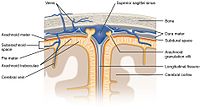
Photo from wikipedia
A woman in her 40s presented with a 3-month history of intermittent bilateral daily headache of moderate intensity. She had severe headaches for almost 1 month prior to the presentation, which… Click to show full abstract
A woman in her 40s presented with a 3-month history of intermittent bilateral daily headache of moderate intensity. She had severe headaches for almost 1 month prior to the presentation, which was aggravated by standing and relieved by lying down. She underwent a non-contrast CT of the head followed by MRI of the brain and spine. Neuroimaging of the brain showed features of intracranial hypotension and spine MRI myelography fast imaging employing steady state acquisition sequences confirmed the site of cerebrospinal fluid (CSF) leak. An epidural blood patch (EBP) was placed to close the CSF leakage site. She had significant improvement in her symptoms and repeat MRI at 4 weeks of follow-up showed resolution of imaging abnormalities. She became symptom-free without the requirement of additional EBP. Our report highlights the importance of suspecting and evaluating spontaneous intracranial hypotension in a patient presented with a typical orthostatic headache. Early intervention and keeping a low threshold for evaluation based on a few early clinical and imaging clues can lead to successful management of such cases.
Journal Title: BMJ Case Reports
Year Published: 2022
Link to full text (if available)
Share on Social Media: Sign Up to like & get
recommendations!